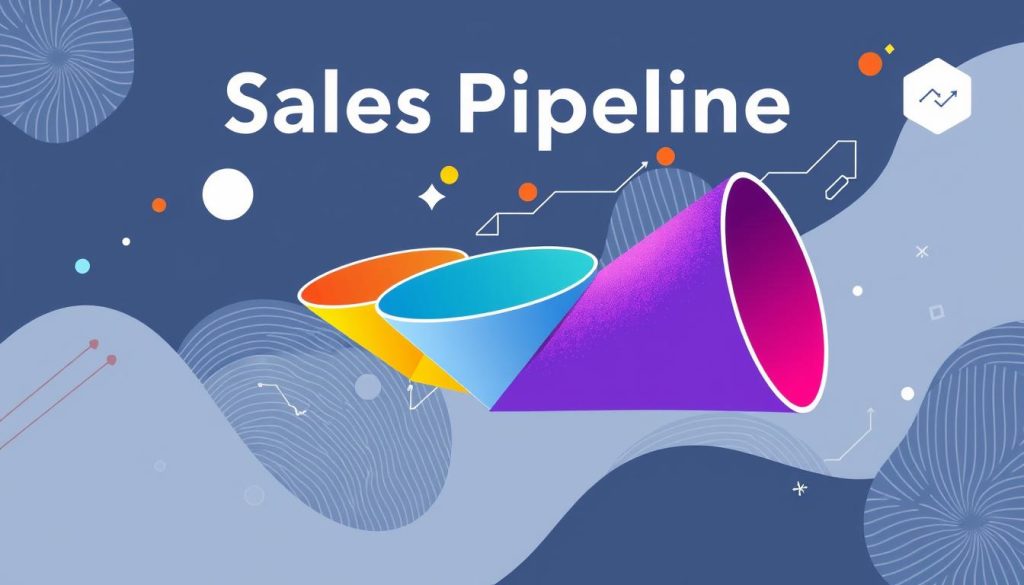Capturing high-quality leads is crucial for sustainable business growth. Demand capture identifies and nurtures potential customers. It’s the foundation for successful sales and marketing efforts.
This guide explores demand capture’s principles and key components. We’ll uncover advanced techniques to boost your lead generation efforts.
We’ll examine the power of intent signals in lead generation. You’ll learn to differentiate between demand generation and capture. We’ll also explore strategies for building a robust sales pipeline.
We’ll discuss market intelligence and buyer intent recognition. You’ll discover how to optimize customer journey maps for maximum conversions.
This article will equip you with a thorough understanding of demand capture. You’ll learn about tools and technologies that streamline your efforts. We’ll share proven methods for creating captivating content.
Get ready to revolutionize your lead generation strategies. These insights will help propel your business to new heights of success.
Key Takeaways
- Understand the fundamental principles of demand capture and its importance in driving high-quality leads
- Explore the role of intent signals and how to leverage them for effective lead generation
- Discover the key components of a successful demand capture strategy
- Learn to differentiate between demand generation and demand capture for optimal results
- Discover how to build a robust sales pipeline through strategic lead generation
Understanding the Fundamentals of Demand Capture
Lead generation is vital for business success. Demand capture helps identify and convert high-intent prospects into valuable leads. By understanding intent signals, businesses can improve their demand capture tactics.
The Role of Intent Signals in Lead Generation
Intent signals are digital clues left by potential customers. These include website interactions and content engagement. They offer insights into audience needs and interests.
By analyzing these signals, businesses can tailor their demand generation efforts. This ensures they reach the right prospects at the right time.
Key Components of Effective Demand Capture
A successful demand capture strategy requires several essential elements:
- Audience Identification: Gaining a deep understanding of your target audience, their pain points, and their buying behavior is crucial for effective demand capture.
- Multichannel Engagement: Leveraging a diverse range of channels, from social media to email, to reach and engage with potential customers.
- Personalized Messaging: Delivering tailored, relevant content and offers that resonate with the specific needs and interests of your prospects.
- Conversion Optimization: Continuously refining your demand capture tactics to improve lead generation and conversion rates.
Differentiating Between Demand Generation and Capture
Demand generation creates awareness and interest in products or services. Demand capture converts interested prospects into qualified leads. Aligning these strategies helps businesses maximize their lead generation efforts.
By combining both approaches, companies can build a robust sales pipeline. This results in more effective customer acquisition and business growth.
“Effective demand capture is the bridge between awareness and conversion, transforming interested prospects into valuable leads.”
Building a Robust Sales Pipeline Through Strategic Lead Generation
A strong sales pipeline is vital for maximizing customer acquisition efforts. Strategic lead generation techniques capture attention and nurture potential customers. These methods guide prospects through the sales funnel effectively.
Identify and leverage intent signals to engage interested customers. These signals include online searches, website interactions, and social media engagement. Respond quickly to these indicators for better lead engagement.
Diversifying your lead generation sources strengthens your sales pipeline. Use content marketing, social media outreach, and targeted advertising campaigns. This approach helps connect with a wider range of potential customers.
Prioritize lead qualification to focus on promising prospects. Assess each lead’s fit and conversion likelihood. This strategy drives higher-quality conversions and sustainable revenue growth.

Effective collaboration between sales and marketing teams is crucial. Align strategies and share valuable insights. This teamwork helps identify, nurture, and convert leads more efficiently.
Implement these lead generation practices for a robust sales pipeline. This approach delivers a steady flow of high-quality leads. Ultimately, it drives long-term success and growth for your business.
Leveraging Market Intelligence for Better Lead Quality
Market intelligence is key for generating high-quality leads in today’s competitive business world. Companies can understand their target audience better by using data-driven decision-making. This approach helps identify trends and optimize lead generation strategies for maximum impact.
Data-Driven Decision Making
Effective lead quality begins with a data-driven approach. Organizations can make informed decisions by analyzing customer behavior patterns and market trends. This mindset helps businesses refine their messaging and tailor their offerings.
Data-driven decisions lead to a more personalized customer experience. This approach aligns with the needs and preferences of the target market.
Competitor Analysis and Market Positioning
Understanding the competitive landscape is crucial for brand differentiation. A thorough competitor analysis can reveal market gaps and unique selling propositions. This knowledge helps position your offerings to stand out in the crowded marketplace.
Market intelligence can be used to attract high-quality leads. These leads are more likely to convert into customers.
Customer Behavior Patterns
- Analyzing customer behavior patterns provides valuable insights into target audience preferences and pain points.
- Businesses can create personalized marketing campaigns and optimize the customer journey using these insights.
- Understanding customer behavior leads to higher-quality leads that are more likely to become loyal customers.
| Key Metric | Importance for Lead Quality | Recommended Tracking Tools |
|---|---|---|
| Website Engagement | Indicates level of interest and intent | Google Analytics, HubSpot, Marketo |
| Lead-to-Customer Conversion Rate | Measures the effectiveness of lead nurturing | CRM software, Marketing Automation Platforms |
| Customer Lifetime Value (CLV) | Helps prioritize high-value leads | Salesforce, Zoho CRM, Intercom |
Market intelligence and data-driven insights help businesses optimize their lead generation strategies. These tools identify high-quality leads and improve overall sales pipeline performance. This approach is essential for driving long-term business growth and success.
Advanced Buyer Intent Recognition Techniques
Identifying high-intent buyers is vital for businesses to boost their prospecting efforts. Advanced techniques dive deep into consumer behavior and preferences. These methods help paint a clearer picture of potential customers.
Predictive analytics is one such technique. It uses machine learning and data-driven insights to forecast buyer intent. This method analyzes browsing behavior, search queries, and digital content engagement.
Businesses can spot individuals likely to convert using this approach. They can then tailor their outreach strategies for better results.
- Contextual Signals: Analyzing the context of a user’s online activities can reveal their needs and pain points.
- Behavioral Cues: Monitoring user interactions helps businesses understand their level of interest and intent.
- Social Signals: Insights from social media platforms can uncover additional buyer intent data.
These advanced techniques offer a deeper understanding of target audiences. They empower businesses to make smarter decisions about prospecting and opportunity identification.
As a result, companies can build a more efficient and effective sales pipeline. This approach ultimately drives better results for the organization.
| Technique | Description | Key Benefits |
|---|---|---|
| Predictive Analytics | Leveraging machine learning and data-driven insights to forecast buyer intent based on various factors | Proactively identify high-intent buyers, enabling more targeted and effective outreach |
| Contextual Signals | Analyzing the context surrounding a user’s online activities, such as web pages visited, content consumed, and search queries | Gain a deeper understanding of user needs and pain points to tailor engagement strategies |
| Behavioral Cues | Monitoring user interactions, such as time spent on a website, actions taken, and visit frequency | Uncover insights about a user’s level of interest and intent, informing prospecting efforts |
| Social Signals | Leveraging insights from social media platforms where users express their interests, preferences, and pain points | Identify additional buyer intent data to complement other sources and improve targeting |

“By harnessing advanced buyer intent recognition techniques, businesses can gain a competitive edge in today’s crowded marketplace, driving better results through more targeted and effective prospecting strategies.”
Optimizing Your Customer Journey Map for Maximum Conversions
A well-crafted customer journey map is key to boosting conversions. It helps businesses improve their customer experience. By studying customer journey mapping, companies can find ways to enhance their conversion optimization tactics.
Touchpoint Analysis
The first step is to understand customer touchpoints. This means looking at where customers interact with your business. A thorough touchpoint analysis helps find problems in the customer experience.
It also shows where you can make things better for your customers. This can lead to a smoother journey for them.
Persona-Based Journey Mapping
Creating journey maps for different buyer types is crucial. It helps tailor the experience to each group’s needs. This approach allows businesses to offer personalized experiences that connect with their target audience.
Conversion Path Optimization
Improving the conversion path is vital for customer journey mapping. This means looking at how customers reach their goals. It involves finding and fixing problems in the process.
The aim is to boost the overall conversion rate. This can lead to more sales and happy customers.
| Key Considerations | Optimization Strategies |
|---|---|
| Touchpoint Analysis |
|
| Persona-Based Journey Mapping |
|
| Conversion Path Optimization |
|
Focusing on customer journey mapping, conversion optimization, and touchpoint analysis can boost lead generation. It helps businesses grow and succeed. These tactics can unlock the full potential of customer acquisition efforts.
Implementing Effective Prospecting Strategies
Effective prospecting is crucial in demand capture. Businesses must explore diverse strategies to build a robust sales pipeline. Tailoring approaches to target audiences can unlock high-quality lead generation opportunities.
Leveraging market intelligence is a powerful prospecting strategy. Analyzing industry trends and customer behavior uncovers untapped opportunity identification areas. This data-driven approach enables more informed decision-making and personalized content creation.
| Prospecting Method | Advantages | Challenges |
|---|---|---|
| Cold Calling | Direct, personal engagement with potential leads | High rejection rates, time-consuming |
| Networking Events | Face-to-face interactions, opportunity to establish rapport | Limited reach, resource-intensive |
| Social Media Outreach | Vast reach, ability to target specific demographics | Potential for spam, limited control over messaging |
| Content Marketing | Builds brand authority, attracts inbound leads | Requires consistent, high-quality content creation |
Embracing diverse prospecting strategies increases chances of identifying quality lead generation opportunities. The key is to remain agile and responsive to market needs. Optimizing customer journeys and using digital tools can enhance prospecting efforts.
Digital Tools and Technologies for Demand Capture
Businesses now have many tools to streamline demand capture. These include CRM integration, marketing automation, and analytics tools. These digital solutions can boost lead generation and nurturing efforts.
CRM Integration Solutions
CRM integration is key for optimizing demand capture strategies. It creates a central hub for managing customer data and tracking sales. This ensures a consistent, personalized experience for leads and customers.
Marketing Automation Platforms
Marketing automation platforms are crucial for modern demand capture. They automate tasks like lead nurturing, email campaigns, and social media management. These tools help optimize lead generation and deliver targeted content.
Analytics and Tracking Tools
Effective demand capture requires understanding your target market and strategy performance. Analytics tools provide insights to inform decision-making and refine your approach. They offer data on web activity, lead sources, and campaign performance.
Integrating these tools creates a comprehensive digital ecosystem for demand capture. This approach ensures a smooth customer journey and improves lead quality. Ultimately, it strengthens your sales pipeline.
Creating Content That Converts Prospects into Leads
Content creation is vital in digital marketing. It captivates your audience and drives lead conversion. Align your strategy with customer preferences to turn prospects into valuable leads.
Explore various content formats to boost your marketing efforts. Blog posts, infographics, videos, and white papers offer unique ways to engage and educate.
Optimizing Content for Lead Conversion
Effective content creation requires understanding your audience and strategic distribution. Use data-driven insights to create content that resonates with prospects. This guides them through the sales funnel smoothly.
- Conduct thorough buyer persona research to identify the unique needs, pain points, and content preferences of your target audience.
- Develop a content calendar that aligns with the various stages of the buyer’s journey, offering valuable information and solutions at each touchpoint.
- Optimize your content for search engine visibility, ensuring that your prospects can easily discover and engage with your offerings.
- Incorporate compelling calls-to-action (CTAs) that effortlessly guide your audience towards lead conversion, whether it’s signing up for a newsletter, downloading a whitepaper, or scheduling a consultation.
Craft content that connects with prospects and guides them to conversion. This unlocks the power of content marketing. It drives sustainable growth for your business.

| Content Format | Advantages for Lead Conversion |
|---|---|
| Blog Posts | Establish thought leadership, educate and inform prospects |
| Infographics | Visually engaging, easy to digest, and shareable |
| Videos | Captivating and memorable, can showcase products or services |
| White Papers | Provide in-depth industry insights and position your brand as an expert |
“Content is the fuel that powers the engine of lead generation and customer acquisition.”
Use diverse content formats to capture your audience’s attention. Optimize them for lead conversion. This guides prospects towards becoming valuable customers for your business.
Measuring and Analyzing Lead Generation Success
Effective lead generation involves understanding strategy performance and optimizing for maximum impact. Let’s explore key metrics, assessment methods, and optimization techniques for driving lead generation success.
Key Performance Indicators
Tracking lead generation metrics is crucial for measuring success. These include lead volume, conversion rate, and cost per lead.
Marketing-qualified leads (MQLs) and sales-qualified leads (SQLs) are also important indicators. Monitoring these metrics provides insights into strategy effectiveness and areas for improvement.
- Lead volume: The total number of leads generated
- Lead conversion rate: The percentage of leads that convert into customers
- Cost per lead: The average cost of acquiring a new lead
- Marketing-qualified leads (MQLs): Leads that have been deemed sales-ready by your marketing team
- Sales-qualified leads (SQLs): Leads that have been qualified by your sales team and are ready for further engagement
ROI Assessment Methods
Calculating the ROI (return on investment) is vital for justifying marketing spend. It ensures strategies deliver tangible business results.
Common ROI assessment methods include:
- Revenue-based ROI: Calculating the revenue generated from leads and comparing it to the cost of lead generation
- Lead-to-customer conversion rate: Measuring the percentage of leads that convert into paying customers
- Lifetime customer value: Estimating the total revenue a customer will generate over the course of their relationship with your business
Performance Optimization Strategies
Use insights from metrics and ROI assessments to implement performance optimization strategies. These can help improve your results continuously.
Effective strategies include:
- A/B testing: Experimenting with different lead capture forms, content, and marketing channels to identify the most effective approaches
- Lead scoring: Developing a system to prioritize and nurture the most promising leads
- Automation and personalization: Leveraging marketing automation and personalization tools to deliver more relevant and timely content to your leads
Focus on measuring, analyzing, and optimizing your lead generation efforts. This approach drives sustainable growth and maximizes your marketing investments.
| Metric | Description | Importance |
|---|---|---|
| Lead Volume | The total number of leads generated | Indicates the overall effectiveness of your lead generation efforts |
| Lead Conversion Rate | The percentage of leads that convert into customers | Measures the efficiency of your lead nurturing and sales processes |
| Cost per Lead | The average cost of acquiring a new lead | Helps you optimize your lead generation budget and strategies |
| MQLs | Leads that have been deemed sales-ready by your marketing team | Provides insight into the quality of your lead generation and nurturing |
| SQLs | Leads that have been qualified by your sales team and are ready for further engagement | Indicates the alignment between your marketing and sales efforts |
Aligning Sales and Marketing for Better Lead Quality
Sales and marketing alignment is crucial for high-quality lead generation. When these teams work together, they create a streamlined approach. This leads to better customer acquisition and tangible benefits.
To align sales and marketing, set shared goals and key performance indicators. Focus on metrics like lead quality and conversion rates. This fosters collaboration and shared accountability between teams.
- Develop a shared understanding of the ideal customer profile and buyer personas
- Implement regular communication channels, such as cross-functional meetings and feedback loops
- Collaborate on lead scoring and qualification criteria to ensure a consistent approach
- Jointly create content and messaging that resonates with the target audience
Invest in technology solutions for data-driven decision-making. Integrate CRM systems with marketing automation platforms. This gives teams a full view of the customer journey.
With this insight, teams can make informed decisions. These choices drive lead quality and customer acquisition. It strengthens sales and marketing alignment.
| Benefits of Sales and Marketing Alignment | Impact on Lead Quality and Customer Acquisition |
|---|---|
| Improved communication and collaboration | Increased lead conversion rates |
| Shared understanding of target audience | Higher customer lifetime value |
| Streamlined lead generation and nurturing | More efficient use of marketing and sales resources |
Foster a culture of alignment between sales and marketing. This unlocks the full potential of lead generation efforts. It drives sustainable growth and boosts profitability for organizations.

Conclusion
Demand capture strategies boost high-quality leads and sales pipelines. We’ve covered intent signals, data-driven decisions, and buyer intent recognition. These tools help optimize the customer journey and elevate lead generation efforts.
Aligning sales and marketing teams is crucial for effective prospecting. Creating engaging content that speaks to your audience unlocks demand capture’s potential. Digital tools like CRM and marketing automation enhance lead generation performance.
Demand capture isn’t a universal solution. It needs a deep grasp of your market and customers. Continuous refinement of strategies is key. This adaptable approach sets your business up for lasting success in customer acquisition.




